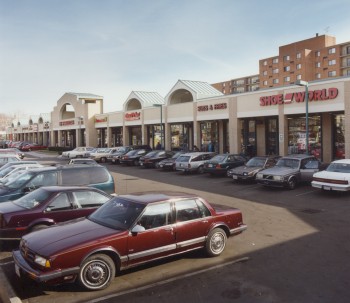If the carcass is the DC Government property portfolio, are eager developers merely the "carrion eaters"?
--------
Reprinted from February 2006--in response to an emergency bill passed last week by the DC City Council to sell off the West End Library and the Firehouse to a local developer as part of a major redevelopment project. See "Sold Out in the West End," a letter to the editor in today's Post, and "Nader Leads Rally Against Plan To Replace West End Library," subtitled "Protesters Say Vote on Popular Branch Lacked Public Input."
--------

Feeding jackals. Is it a stretch to think that developers are eager to feed on the property portfolio of the DC Government? Image from the One World Foundation.
Judging by the news, developers are circling over the carcass of the public assets (publicly-owned property portfolio) "owned" by the DC Government in Trust for the citizens and residents of the District of Columbia.
Today's Post has a story by Debbi Wilgoren, "D.C. Deal Could Get Schools, Libraries: City Would Let Developers Build Housing, Shops," about something that advocates have been bringing attention to with increasing fervor, that many developers want to buy DC Government owned properties, and there are few if any satisfying practices and policies to deal with this, practices and policies that would foremost protect and guarantee that neighborhood and citizen needs remain paramount in the process.
You can see how the reportage is building up to the "solution" of selling off the public's assets when you see other articles like this from yesterday, "Libraries Could Get Federal Funding," or this from today's Post, "Spending on Underused Facilities Saps D.C. Schools, Study Finds."
Is the solution to underperforming schools and libraries to sell them off?
It hasn't worked too well for Britain's railroads...the Bush Administration trumpets the British Railway privatization as an example for Amtrak, yet the price for a rail trip in Britain is double the cost of trips of roughly the same distance in France, and few rail experts think that the UK rail privatization exercise has been a success. See "US Federal Rail Policy: Learning from Worst Practices" and this op-ed from the International Herald-Tribune, "The Privatization of Public Utilities Can Be a Disaster."
Does anybody remember this Post story from 2004, "Charter School Measure Slips Into District Law: City Furious That It Wasn't Consulted" (By Valerie Strauss, 11/4/2004; Page B10) that starts with this:
Without consulting with District officials, Congress approved legislation last month that requires the city to offer any surplus school property to public charter schools for at least 25 percent less than its appraised value before selling it to anyone else.
and then wonder what the powers-that-be have planned for the rest of the DC Government property inventory?
This apparent desire to sell is a concern with the "surplus" school property inventory, where Congress has given charter schools the ability to trump any sound offer, and get a price discount to boot.
This is a concern with the surplus property inventory generally, in that the City appears to be without a comprehensive portfolio management strategy, that each agency for the most part controls its properties independent of other city agencies and the needs of the city as a whole, and it appears as if there is no strategy, other than the ad hoc creation of RFPs to guide the sale of each property, in an overly accelerated time frame, to weigh proposals to buy city-owned properties against neighborhood and other professed city goals and objectives.
(Note that we don't really have neighborhood plans for every neighorhood, and that the Strategic Neighborhood Action Plans created in 2001-2002 aren't really substantive neighborhood plans. In many cases they are a laundry list of community desires.)
See previous blog entries "No further public use" (December) and "The drumbeat for selling off school property is getting louder and louder" (November), and "Call To Action: Stop the Plan to Privatize our Public School System" (November) for a more detailed discussion of some of these issues.
The People's Property Campaign, led by EmpowerDC, has been created by a number of groups to address this failure to protect public assets in the District of Columbia.
The Wilgoren article today is over the top... From the article:
The District of Columbia is studded with worn-out municipal buildings, many surrounded by the gleaming office and apartment towers of today's construction boom. The old schools and libraries need to be replaced. Developers are hungry for space for even more condominiums. So D.C. officials want to make a deal: The developers would build new libraries, schools and maybe even police stations, and get the privilege of putting condominiums or shops on top of or alongside them.
Actually, as a person fully committed to sustainable land use and resource planning, I have no problem with mixed-use developments involving municipally-owned land. For example, the Hong Kong Transit system gets 50% of its revenue from development at and around its stations, capturing property value increases that result from public investment, and using the revenue to run the transit system.
It's true that the DC Government and its instrumentalities (see yesterday's blog entry "Is any business better than no business, or is a better business better than any business?") do such a terrible job in managing their properties in ways that improve rather than destabilize communities, and generally fail to protect citizen interests (i.e., the land at the Brentwood Shopping Center was sold to the developer without ensuring that if developments--such as KMart--fell through, that ownership would revert back to the DC Government).
Therefore as a citizen, it's difficult to look at this bill: Public Facilities Modernization Through Air Rights Development Act of 2005; without a great deal of trepidation and concern and a belief that once more, residents and the city coffers are likely to get "schooled." (See the debacle of the Baseball Stadium lease if you need further references.)

We all know the saying, "Fool me once, shame on you. Fool me twice, shame on me." Is the District of Columbia ready to be portrayed by Salma Hayek?
Quoting people like Bob Peck, who has run the area's leading business trade group, the Greater Washington Board of Trade, saying
"It's kind of nice to see people catching on," said Robert A. Peck, a former appointee to the Board of Education and former president of the Greater Washington Board of Trade. For the city, Peck said, "This is the way to get someone else to borrow the big money and get a return on your valuable property"
is a concern given that business groups like the Federal City Council and the GWBOT aren't at the forefront of protecting citizen interests at the expense of their big business members. That John Hill, director of the Federal City Council, is the president of the DC Public Library Board of Trustees, should cause further concern, because organizations such as those represented by Peck and Hill have not demonstrated that they are committed to building a Livable and Inclusive City for all as much as they are about land use development, and reducing the risk and maximizing the investments of their developer members.
The Wilgoren article "complains" that public-private partnerships for redevelopment at Sumner School or Oyster School "took years to accomplish" yet the fact is that these buildings are still owned by the municipal government, and at least with Sumner, after the term of the lease expires, the city will own an office building worth hundreds of millions of dollars! Compare that to the average deal that sells a city-owned property for but a one-time financial gain.
In the meantime Sumner School was rehabilitated and is maintained and operated at zero cost to the DC Government for the entire 99 year term of the lease while it is used as the school system archives and museum.
The Sumner deal, a lease rather than a sale, and a lease with enforceable and ongoing provisions for public benefits is the exception that proves that rule, that only in exceptional instances do long term benefits accrue from the "disposition" of city-owned properties.
Compare Sumner to Franklin School, the former home of the Board of Education. Franklin's facade was rehabilitated as part of an associated PUD agreement, yet no far-reaching plan was created to rehabilitate the interior and the building languished and is now being converted into a privately owned hotel.
DC Government is known for seeking the quick buck and failing to protect the long term interests of citizens.
And as an involved citizen knows, it is the rare developer that wants to do anything other than get in and out and the least possible cost and the greatest profit. Providing public benefits costs money.
Furthermore, the city in particular the Zoning Commission, provide little if any guidance and structure and assistance to neighborhood groups negotiating with developers and their highly-paid land use lawyers, over the proffers of community amenities.
Meetings with developers and the Office of Planning over PUD and community amenity matters tend to be "private" affairs without neighborhood advocates present. And given the "suasion" power that developers have, it's very easy (and inexpensive) to co-opt many if not most neighborhood advocates.
What happens then is there are tremendous anomalies in the proffers received by various neighborhoods. So a Ward 5 project yields $165,000 in benefits for the local school, library, and the major community organization, while a project 10 times the size in the H Street NE neighborhood yielded almost nothing, absolutely nothing, for the community, given the smart and select strategy of co-optation and the weak nature of the ANC's oversight of the project.
I am not a constitutional law expert, but I truly believe that such anomalies are a violation of the equal protection clause of the 14th Amendment of the Constitution, although lawyers I've run the argument by believe it would be difficult to prove wilfull violation.
Irrespective of the "Air Rights" Legislation, the Community Amenities Negotiating Process Must be Tightened Up in a Manner that ensures the Community truly benefits
Through my participation on the ANC6C Planning and Zoning Committee since 2003, I have become increasingly concerned about the lack of structure in shaping citizen participation in negotiation of such agreements, the lack of transparency of agreements negotiated between developers and local nonprofits deemed "community organizations" to determine how monetary benefits are spent, as well as working to garner amenities that significantly contribute to substantive structural improvements in the neighborhood and at the city at large.
Community Amenities in development agreements can be conceptualized as being comprised of three different types:
1. City-wide benefits;
2. Neighborhood benefits within a geographically defined area such as an ANC;
3. Micro-benefits within a couple block radius of the project.
The first category covers things like green roofs, affordable housing, DC-based employment agreements, minority contracting requirements, etc. For many projects, doing the kinds of things listed is merely good business, and shouldn't be considered a substantive proffer. And these are really ways to achieve public policies that serve the city more broadly, rather than the specific neighborhood in which a project is located.
The second category would encompass proffers that are directed to facilities and organizations located within the defined geographical area where the project is located, such as those beneficiaries mentioned above in the Ward 5 project--but contributions must be substantive, yielding long-term benefits and consequences, rather than "flash in the pan" benefits with little in the way of structural impact.
The third category could be items like streetscape improvements on the block of the project--micro projects benefiting the immediate area around the project, the area that is most impacted physically, and on a day-to-day basis, by the project both during construction, and after it is finished.
Having a structured conversation about community benefits is a necessary first step in the consideration of a wider-range of public-private partnerships organized around land use and development that is designed to yield neighborhood and/or city-wide stabilization and improvement benefits.
Without such a conversation, judging by my experiences thus far, I think it's a very real concern that DC residents could get screwed, with very little to show for it, sort of how I feel about the $200 million or so invested in projects along the H Street corridor from the mid-1970s through 2003.
This year, the H Street Connection is 20 years old--and the roughly one city block that the project takes up was sold to the developer for but $500,000. The same developer is in line to get the rights to redevelop Skyland Center for a song too.

The H Street Connection was developed as a part of the post-riot H Street Urban Renewal Plan and it shares typical automobile-oriented characteristics of such development. Typically, urban renewal-oriented development is not beneficial to the long-term revitalization of neighborhoods in traditional center cities.
It is a history of such deals that has to make advocates very concerned about the circling of developers over the carcass of the DC Government property inventory.
Other resources to consider include this handbook, "Community Benefits Agreements: Making Development Projects Accountable," and this article from the New York Times, SQUARE FEET; The Trade-Offs in Zoning Trade-Offs," which is summarized thusly:
Since 1961, when the first density bonus was codified into city zoning law, public amenity trade-offs have proliferated. The Hearst Tower, under construction at Eighth Avenue and 57th Street, was granted a density bonus in exchange for making improvements to the Columbus Circle subway station. The Biltmore Theater on 47th Street was fully restored by the developer of a residential tower on that street.
More common, however, are spaces that have been taken over for private purposes. For example, many spaces that were created for the public have been appropriated for cafe seating, a common violation of the density bonus that was publicized by Jerold Kayden, a professor of urban planning and design at the Harvard University Graduate School of Design, in his extensive study of public spaces created in New York City since 1961.
After the study was published, the city started enforcement procedures against a number of building owners, and Professor Kayden established a small nonprofit monitoring group called Advocates for Privately Owned Public Spaces, which is financed by the Municipal Art Society. The group keeps an updated database of more than 500 public spaces, but has neither the staff nor the resources to track public amenities built by private developers that are not regulated by city zoning laws.
______________
As I pointed out in the blog entry last week about Arlington County's capital improvements database, which is now publicly accessible, we need a similar database, publicly accessible, that lists all properties owned by the DC Government and its instrumentalities such as the National Capital Revitalization Corporation and the Anacostia Waterfront Corporation, not to mention Community Development Corporations, and any and all such agreements associated with the property, and a system for monitoring and tracking compliance. (See "A laudable example of municipal transparency: Arlington opens municipal construction project tracking database to the public.")
Doesn't anybody remember the great reporting in The Common Denominator about the community amenities agreements associated with development at Fort Lincoln, agreements that have never been effectuated, and the fact that the DC Government isn't too worked up about this? (See May 6, 2002 - News - Residents cry foul: Ft. Lincoln developer reneges on city deal that delivered land rights; June 3, 2002 - News - Fort Lincoln residents seek Norton's help; August 12, 2002 - News - Residents sue, charge Ft. Lincoln New Town developer with fraud; and May 6, 2002 - News - LBJ's 'Great Society' spawned Fort Lincoln development plan all from The Common Denominator.)
Given such a track record, how can even the most ardent mixed-use proponent look upon this drumbeat to "dispose" of the public's assets with anything but fear?

Should we assign developer names to the vultures in this painting? Artist: Leslie Staub, "Carrion Eaters," 48 x 53 inches, Oil on wood.
Labels: bad government, civic engagement, good government, government oversight, legislative process, public assets, urban revitalization



0 Comments:
Post a Comment
<< Home